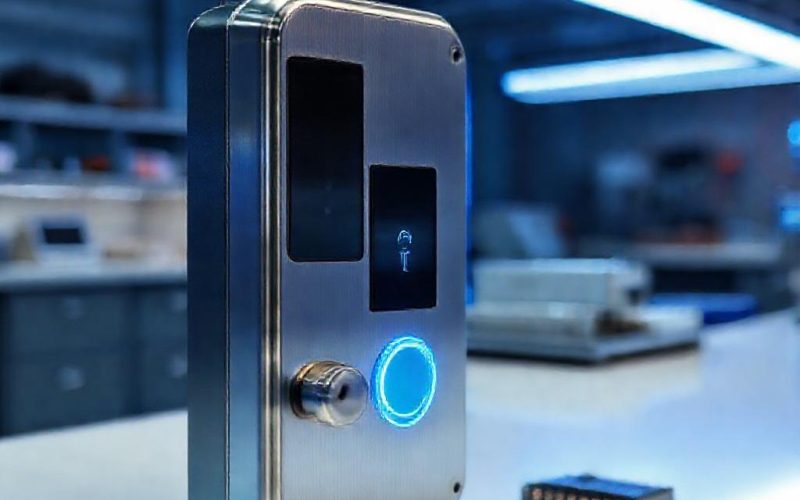Table of Contents Show
Imagine walking up to your front door and having it unlock automatically as you approach—no fumbling for keys or remembering complex passcodes. This futuristic convenience is now within reach thanks to smart door locks powered by face recognition technology. By combining Arduino’s versatility with advanced face recognition algorithms, you can build a secure, automated door lock system that blends cutting-edge tech with DIY ingenuity. Whether you’re a tech enthusiast looking to upgrade your home security or an engineer exploring IoT applications, this guide will walk you through every step of creating a functional smart door lock from scratch.
Hardware Components
To build your smart door lock, you’ll need the following hardware:
- Arduino Board (e.g., Arduino Uno or Mega): The brain of the system, responsible for processing inputs and controlling outputs.
- Servo Motor or Locking Mechanism: Acts as the physical door lock, triggered by the Arduino to unlock or lock the door.
- Face Recognition Camera (e.g., ESP32-CAM or Raspberry Pi Camera): Captures images of individuals approaching the door for authentication.
- Breadboard and Jumper Wires: For prototyping and connecting components.
- Power Supply: Ensures reliable operation of the Arduino and camera.
Software Requirements
The software stack includes:
- Arduino IDE: For programming the Arduino board.
- OpenCV: A library for real-time face detection and recognition.
- TensorFlow Lite: Lightweight machine learning framework for deploying face recognition models on Arduino.
- Face Recognition Libraries: Such as face-recognition-python or similar for training and detection.
Setting Up the Hardware
Assembling the Circuit
Follow these steps to connect your components:
- Connect the servo motor to the Arduino’s PWM pin (e.g., pin 9) and power it using an external 5V supply if needed.
- Wire the camera module to the Arduino via SPI or I2C interface, depending on the camera model.
- Ensure all connections are secure and test power supply stability to avoid voltage drops.
Mounting the Components
For optimal performance:
- Position the camera at eye level for clear face capture, avoiding glare from direct sunlight.
- Secure the servo motor to the door frame or lock mechanism using brackets or adhesive.
- Test the camera’s field of view to ensure it captures faces accurately from a distance.
Implementing Face Recognition
Training the Face Recognition Model
To train the model:
- Collect multiple images of authorized users under different lighting conditions.
- Use OpenCV or a similar tool to extract face encodings and store them in a dataset.
- Convert the trained model into a format compatible with Arduino, such as TensorFlow Lite.
Integrating the Model with Arduino
Upload the face recognition code to the Arduino by:
Progress Overview
Progress analysis for Create a Smart Door Lock Using Face Recognition and Arduino

- Including necessary libraries in the Arduino IDE.
- Writing code to capture images via the camera and compare them against stored encodings.
- Setting thresholds for recognition accuracy to minimize false positives.
Programming the Smart Lock System
Basic Arduino Code Structure
The code should:

- Initialize the camera and servo motor in the setup function.
- Continuously capture images and send them to the face recognition model in the loop.
- Define functions to process recognition results and control the servo.
Adding Authentication Logic
Implement logic to:
- Compare captured faces against the stored dataset.
- Trigger the servo to unlock the door if a match is found (e.g., confidence > 90%).
- Re-lock the door after a timeout period for security.
Enhancing Security Features
Consider adding:
- A backup PIN code or physical key for emergencies.
- Logging mechanisms to track unauthorized access attempts.
- Alerts via SMS or email for suspicious activity.
Testing and Troubleshooting
Running Initial Tests
Verify the system by:

- Testing the camera’s ability to capture clear images.
- Checking if the servo responds correctly to unlock/lock commands.
- Ensuring the face recognition model performs accurately.
Common Issues and Fixes
Troubleshoot problems like:
- False Positives/Negatives: Adjust recognition thresholds or retrain the model.
- Wiring Errors: Double-check connections and power supply.
- Camera Malfunctions: Ensure proper lighting and lens cleanliness.
Expanding the Project (Optional Enhancements)
Connecting to IoT Systems
Enhance functionality by:
- Integrating with Home Assistant or Alexa for voice control.
- Developing a mobile app to remotely monitor and control the lock.
Adding Biometric or RFID Backup
For added security, combine face recognition with:
- Fingerprint scanning modules.
- RFID or NFC tags for alternative authentication.
Conclusion
Building a smart door lock with face recognition and Arduino is a rewarding project that combines hardware and software skills. By following this guide, you’ve created a secure, automated system that can be further customized with IoT integrations or additional biometric features. Whether for personal use or as a prototype for larger projects, this DIY smart lock demonstrates the power of accessible technology in enhancing everyday convenience and security. Now, it’s time to experiment, refine, and explore even more advanced applications!
FAQ Section
Q1: Can this system work with multiple users?
Yes, by training the model with multiple face datasets, the system can recognize and authenticate multiple authorized users.
Q2: How secure is face recognition for a door lock?
Face recognition is highly secure if implemented correctly, with false rejection/acceptance rates minimized through proper training and encryption. However, backup authentication methods are recommended for emergencies.
Q3: What happens if the camera malfunctions?
To handle camera failures, implement backup methods like manual override keys or secondary authentication (e.g., PIN codes or RFID). Regular maintenance ensures long-term reliability.
Q4: Can I use a Raspberry Pi instead of Arduino?
Yes, a Raspberry Pi offers more processing power for complex face recognition tasks, but Arduino is simpler for basic implementations. Choose based on your project’s complexity and familiarity with the platform.
Q5: How do I improve recognition accuracy in low light?
Use infrared (IR) cameras for better low-light performance, or install external lighting near the door to ensure clear face capture.




